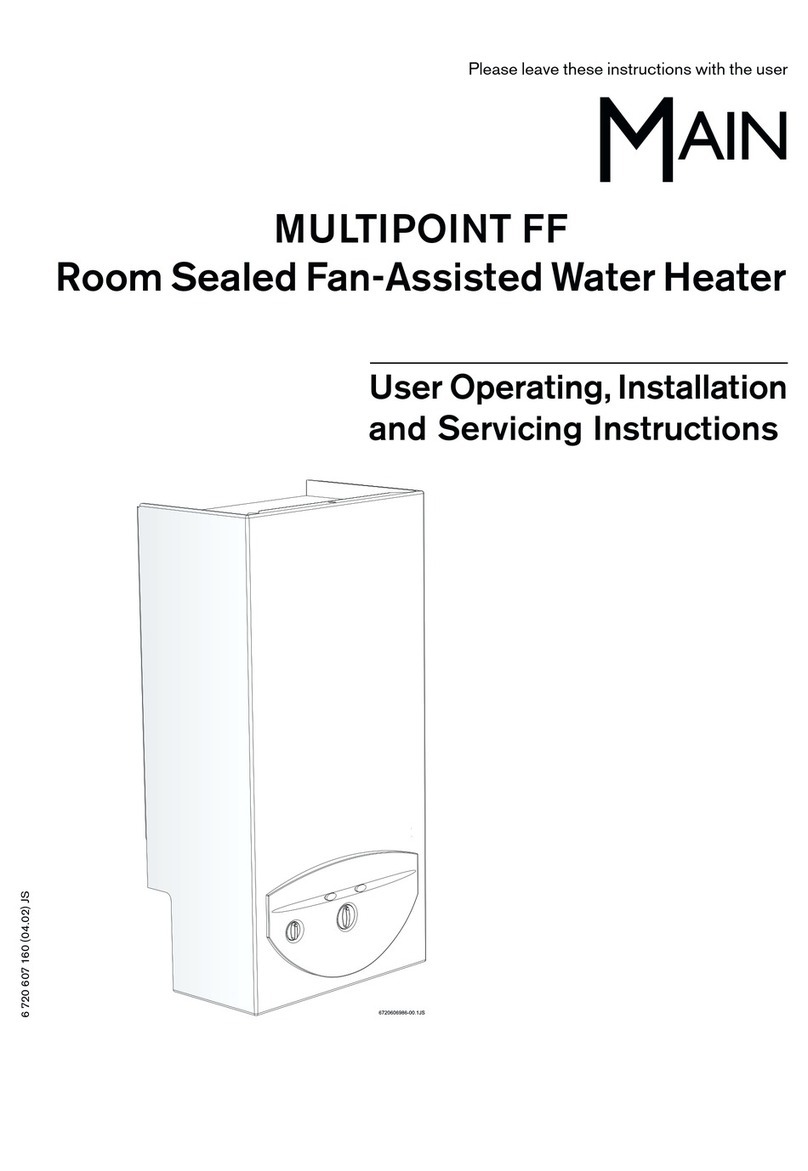9
Part No. 5000893
2. Installation Requirements
•Codes of Practice
The appliance is suitable only for installation in GB and
IE and should be installed in accordance with the rules
in force. In GB, the installation must be carried out by
a CORGI Registered Installer. It must be carried out in
accordance with the relevant requirements of the:
•Gas Safety (Installation & Use) Regulations.
•The appropriate Building Regulations either The
Building Regulations, The Building Regulations
(Scotland), Building Regulations (Northern Ireland).
•The Water Fittings Regulations or Water byelaws in
Scotland.
Where no specific instructions are given, reference
should be made to the relevant British Standard Codes
of Practice.
In IE, the installation must be carried out by a Competent
Person and installed in accordance with the current
edition of I.S. 813 "Domestic Gas Installations" and the
current Building Regulations.
•Health and Safety Information
Under the Consumer Protection Act 1987 and Section
6 of the Health and Safety at Work Act 1974, we are
required to provide information on substances
hazardous to health. Small quantities of adhesives and
sealants used in the product are cured and present no
known hazards.The following substances are also
present.
Important: Later products are fitted with heat exchangers
that have a painted coating (in place of lead/tin) and
present no known hazards.
Insulation and Seals
Material - Man Made Mineral Fibre.
Description - Boards, Ropes, Gaskets.
Known Hazards - Some people can suffer reddening and
itching of the skin.Fibre entry into the eye will cause foreign
body irritation which can cause severe irritation to people
wearing contact lenses. Irritation to respiratory tract.
Precautions - Dust goggles will protect eyes.People with a
history of skin complaints may be particularly susceptible to
irritation. High dust levels are only likely to arise following
harsh abrasion. In general, normal handling and use will
not present high risk, follow good hygiene practices, wash
hands before, touching eyes, consuming food, drinking or
using the toilet.
First Aid - Medical attention must be sought following eye
contact or prolonged reddening of the skin.
Heat Exchanger
Material - Copper with lead/tin coating.
Description - Finned copper tube.
Known Hazards - Inhalation or ingestion of lead dust or
fumes may cause headache and nausea.
Precautions - Unused heat exchangers present minimal
Installation Requirements
risk to health other than normal hygiene practices would
demand regarding washing before eating etc. Deposits
found on or below a heat exchanger that has been in use
could contain lead oxide. Avoid inhalation by using a
vacuum cleaner in conjunction with other cleaning tools
when servicing the boiler.
•Energy Cut-Off Device
This appliance contains an Energy Cut-Off Device that
will shut down the gas supply to the appliance if the water
in the heat exchanger exceeds the anticipated
temperature.
•Under Draining Board Installations
This appliance can be installed under a draining board,
a kit (Sales Code 22/18276) is available that contains
connection bends and a sheet showing recommended
pipework layouts.
•Ventilation
It is not necessary to have a purpose provided air vent in
the room or internal space in which the Water Heater is
installed. If the Water Heater is to be installed in a
cupboard or compartment, permanent air vents are not
required. Detail recommendations for air supply are given
in BS 5440:2.
•Installation
IMPORTANT: The area of wall covered by the appliance
must be flat.
The clearances required around the Flue Terminal are
shown on the Flue Template supplied with the Terminal
Pack.
The appliance must be fitted on an external wall to allow
the Flue Terminal to pass directly through the wall to the
outside air.
The Water Heater is suitable for installation against a
combustible wall e.g. wood cladding, provided the flue
duct is not closer than 25mm to combustible material. A
non-combustible sleeve should be installed to surround
the flue duct to provide a 25mm annular space. Further
guidence is given in BS5440:1
If the water heater is to be fitted into a building of
timber frame construction then reference must be
made to the current edition of Institution of Gas Engineers
Publication IGE/UP/7/ (Gas Installation in Timber Framed
Housing).
If the appliance is to be installed into a ‘‘SEDUCT’’ the
minimum duct required is 228 mm (9 in.) deep, 349 mm
(15fiin.) wide.
This appliance may take the place of an existing
appliance and will mount onto the original flue terminal
of any of the following: AVON, BRISTOL, MEDINA,
MEDINA D/L, MEDWAY, MERSEY, SEVERN 3,
SEVERN 4, SEVERN 5 and TRENT.





























